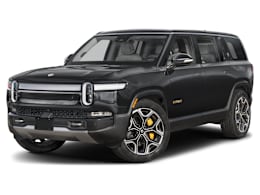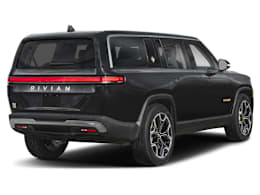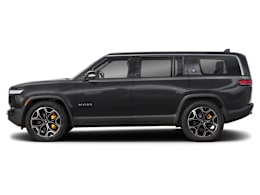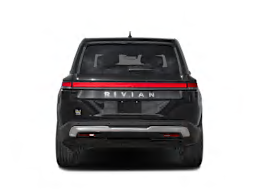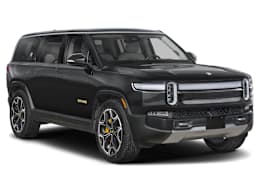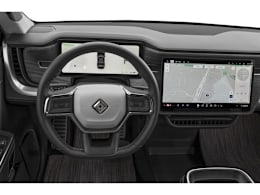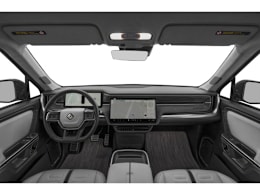Rivian refreshed its R1S three-row electric SUV for 2025 to iron out some of the original version's flaws. The changes are more incremental than monumental, but we credit Rivian for making the powertrain smoother, giving it a slightly more absorbent ride, and a quieter cabin. The improvements resulted in a higher road-test score than before, although it still lags behind both luxury and non-luxury EV SUV competitors.
Thanks to a generous 533 hp in the dual-motor model we tested, the R1S remains super quick, and with a generous driving range to boot. Owners are also sure to appreciate the plentiful driver and passenger space, along with the ample cargo room, including a useful front trunk.
But many of the issues that plagued the original R1S are still present in this refreshed generation, just to a lesser extent in some cases. For example, while the ride is better, it’s still too stiff and bouncy, the steering is unnaturally quick, and it takes extra concentration to drive the R1S smoothly at low speeds thanks to its aggressive regenerative-braking system. Then there’s the unintuitive interior controls: Far too much reliance is placed on the center-dash infotainment touchscreen for even basic functions, such as adjusting the side mirrors, steering wheel, or the air vents, which adds to driver distraction.
“It's a better, more developed vehicle than the original R1S, but it still lacks driving refinement,” said a tester. “The ride has improved slightly and the handling is less twitchy, but it still feels odd to drive and ultimately it’s not a very comfortable experience.”
“It’s smoother, quieter, more refined, and more befitting of its price tag. Where the original one felt and sounded like it might fall apart on rough roads, this one feels more solid and well-built,” said another tester. “Unfortunately, there are still aspects of this vehicle that are lagging behind the competition, such as ride quality, noise isolation, and the strange handling characteristics.”
Another tester was less positive about the R1S’ changes, saying, “It doesn’t feel significantly improved over the original to me. The suspension is oversprung and underdamped. Regen is too intense, and the controls seem like they were designed to maximize distraction.”
We bought a 2025 Rivian R1S Dual Max for $94,550 (anonymously, as we do with every vehicle we test) for the purpose of this road test review. Our R1S was assembled in Normal, Illinois.
Driving experience
“Immensely powerful,” said a tester about the second-gen dual-motor R1S we tested. Sure, it “only” has 533 hp instead of the over-the-top 835 hp of the original quad-motor model that we tested previously. But trust us, this is still a thrillingly quick vehicle to drive. It bolted from 0 to 60 mph in 4.6 seconds, which is quite speedy for a 6,660-pound SUV. While that pales compared to the 3.5 second sprint of the quad-motor, this one feels more of-one-piece, like the all-wheel-drive system can manage the torque with more aplomb.
Rivian improved the tuning of the accelerator pedal and toned down the regenerative-braking slightly, which results in a more refined driving experience. The lowest regen-setting is much easier to use than before, without a sudden onset of braking. The Standard setting is more manageable as a “one-pedal driving” setup, allowing you to use just the accelerator pedal for both speeding up and slowing the vehicle down. Unfortunately, the regen at very low speeds—like maneuvering in a driveway, reversing, or turning around—remains too intense, making it feel like the parking brake is thrown on as soon as you release pressure off the accelerator pedal.
The dual-motor model we tested with the larger battery pack (“Max,” as Rivian calls it) has an EPA-estimated driving range of 410 miles. Although it only managed 358 miles during our 70-mph highway-range test, that’s still a pretty luxurious range. The huge 144-kilowatt-hour battery takes about 15 hours to recharge from empty on a 240-volt, Level 2 home-charging system, gaining about 28 miles of range per hour. The R1S’ 220-watt max acceptance rate at public DC fast-charging stations equates to about nine miles of range gained per minute.
Although Rivian seems to have dialed the R1S’ handling back a skosh, it’s still a very agile vehicle, especially considering its size and weight. The two aspects that make it feel incredibly nimble—ultra-quick steering and hardly any body roll—also contribute to it feeling unnatural, especially when you wick up the electrons on a twisty road. Combined with vague steering that telegraphs almost nothing to the driver, it’s lacking a good connection to the road. Even driving on the highway is odd and frankly unpleasant, due to the darty steering that makes the driver “work” to keep the vehicle going straight.
The original R1S was far too stiff and jumpy when driving on any kind of rough road. The new one is better with a more compliant feel, but the bar had been set very low. As such, the overly-firm suspension still gives the SUV an unrefined vibe, rather than a luxurious one. Far too many hard hits punch through into the cabin, and things like potholes strike through with excessive force. The body gets unsettled, too, with quite a bit of front-to-rear pitching.
We found the cabin slightly quieter than the last R1S. There’s still more electric-motor whine than with most EVs, although there’s less this time around, likely in part because there are two fewer motors at play. There’s also an abundance of wind noise on the highway.
Cabin comfort
As with the original R1S, the cabin shows excellent attention to detail with a premium, high-tech look. We love the metal accents on the doors and seats, and the natural, untreated feel of the wood trim. There’s plenty of exposed stitching and a fair amount of padded surfaces, but we miss the super-soft micro-suede headliner that was on our last R1S, replaced by a nearly unpadded polyester material.
We appreciate the spacious driving position, which has an elevated seat height and lots of headroom. The wide front seats provided good comfort and support for some of our drivers. But others found them lumpy, with odd pressure points on the upper portion of the seatback. The second-row seat is roomy, with decent headroom and ample knee room. It's quite flat, though, and ultimately not the most comfortable. The second-row seat can tilt and slide forward with a slick one-button operation to access the third row. It’s relatively spacious back there, but the seat isn’t very comfortable due to a lack of thigh support and flat-as-a-board cushion shape. Overall, the second- and third-row space is closer to that of a Toyota Highlander rather than the larger Grand Highlander or Honda Pilot.
Unlike many conventional competitors, the R1S can carry seven people and their luggage, thanks to its front trunk (also known as a “frunk”) and a deep well behind the third row.
Controls and usability
The R1S’ controls remain unintuitive and distracting due to a lack of traditional, easy-to-use physical controls for the side mirrors, steering-wheel adjustment, and dashboard air vents. Nearly every interior function has to go through the oversized center-dash infotainment touchscreen. The steering wheel controls remain unlabeled, and many common functions take multiple steps to access and adjust. And, as before, that the R1S isn’t compatible with Android Auto or Apple CarPlay only makes things worse.
Active safety and driver assistance
Standard active safety and driver assistance features include automatic emergency braking with pedestrian and cyclist detection, automatic emergency braking that operates at highway speeds, blind spot warning, rear cross traffic warning, lane centering assistance, lane departure warning, lane keeping assistance, adaptive cruise control, and automatic high beams.
It’s unfortunate that the R1S lacks much in the way of additional safety features for rear-seat occupants. It doesn’t have seat belt load-limiters, nor does it come with a rear occupant alert system which can help prevent children and pets from suffering heatstroke or hypothermia if unintentionally left behind in the vehicle. At least it has a rear belt minder, which alerts the driver if a rear passenger unbuckles their seat belt during the trip.



















